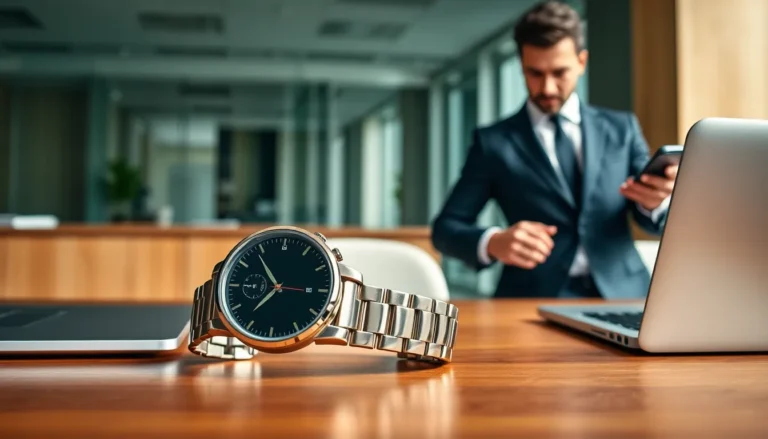Ever found yourself in a situation where your iPhone decides that the only way to communicate is through its loudspeaker? It’s like your phone’s taken a vow of silence, leaving you to navigate the world of awkward speakerphone conversations. Whether you’re in the middle of a meeting or trying to sneak in a chat during dinner, this quirky issue can turn everyday interactions into a comedy of errors.
But don’t fret just yet! This article dives into the reasons behind your iPhone’s sudden preference for speaker mode and offers some practical solutions. With a sprinkle of humor and a dash of tech know-how, it’ll help you reclaim your private conversations. So, grab your phone and let’s troubleshoot this mystery together—because who wants to broadcast their life to the world when they can enjoy a little privacy?
Table of Contents
ToggleUnderstanding the Issue
When an iPhone only plays audio through the speaker, it signals a disruption in normal operation. Users often experience this during calls, leading to uncomfortable situations.
Common Symptoms
Experiencing audio solely through the speaker presents clear symptoms. Calls initiate with sound only from the speaker. Users notice that earpiece audio remains silent. Notifications and alarms may also sound only through the speaker, failing to switch to earpiece mode. Conversations become challenging, with privacy compromised during sensitive discussions.
Possible Causes
Multiple factors contribute to this speaker-only issue. Software glitches often prevent the device from recognizing earpiece functionality. Recent updates might conflict with audio settings, prompting unexpected behavior. Dust or debris could obstruct the earpiece, impacting sound delivery. Hardware failures, although less common, can occur, affecting internal components. These causes disrupt typical audio experiences, necessitating troubleshooting.
Troubleshooting Steps
Resolving the issue of only hearing audio through the iPhone’s speaker requires several systematic troubleshooting steps.
Check Volume and Settings
Confirming the volume settings on the iPhone is crucial. The volume may be inadvertently set too low or muted. Users should adjust the ringer and alerts volume from the Settings app. Additionally, check if the phone is in Do Not Disturb mode, which can affect audio output. Inspecting the audio output settings is also important. Some users may have unknowingly selected Bluetooth or external audio devices as the default output source. Ensuring that no audio accessories are connected provides clarity on the audio route.
Restart Your iPhone
Restarting the iPhone often resolves temporary glitches causing audio issues. To do this, press and hold the power button until the slider appears, then slide to power off. Wait for about 30 seconds before turning the device back on, allowing the system to refresh. After restarting, test the call functionality again. This simple reset can clear software conflicts and restore proper audio operation. If problems persist after restarting, further investigation into hardware and software settings may be necessary.
Hardware Checks
When an iPhone only plays audio through the speaker, checking hardware components is crucial. Certain issues may stem from the device’s physical condition.
Inspect the Speaker
Dust and debris can obstruct the speaker, leading to audio issues. Use a soft, dry cloth to gently wipe the speaker grille. Clearing away any blockages may improve sound output. Inspecting the speaker for physical damage is important too; look for cracks or dents that could affect performance. Ensuring that there’s no moisture exposure contributes to preventing further complications. Regular checks keep the device running efficiently.
Test with Headphones
Using headphones helps isolate audio problems. Plug in a pair of wired or connect Bluetooth headphones to determine if sound works correctly. If audio plays properly through headphones, the issue likely lies with the iPhone’s speaker. Disconnecting and reconnecting the headphones can refresh the audio output settings. Testing multiple headphone types may highlight compatibility issues as well. This simple test can clarify whether hardware repairs are necessary.
Software Solutions
Addressing the issue of only hearing audio through the iPhone’s speaker involves several software solutions that can restore proper functionality.
Update iOS
Updating iOS often resolves audio-related problems. When software glitches occur, they may stem from outdated versions of the operating system. Users can navigate to Settings, select General, then tap on Software Update to check for available updates. Installing the latest version typically improves system performance, eliminates bugs, and enhances overall compatibility with apps and features. Ensuring the device runs the latest software ensures optimal audio playback and potentially fixes the speaker-only issue.
Reset All Settings
Resetting all settings can also be an effective solution. This action restores settings to default without erasing personal data. Users can access this option through Settings, then tap General, followed by Reset. Selecting Reset All Settings prompts confirmation, which is necessary for completion. After resetting, volume preferences, network configurations, and display settings revert to original states. This process can clear out any conflicting settings that might block audio from the earpiece, effectively resolving the problem of sound only through the speaker.
When to Seek Professional Help
If troubleshooting fails to resolve the audio issues on an iPhone, users may consider seeking professional assistance. The following options provide avenues for effective support.
Contact Apple Support
Reaching out to Apple Support can offer tailored solutions for specific issues. Users can access support through the Apple website, the Apple Support app, or by calling the support hotline. Details about the device, such as model and iOS version, enhance the effectiveness of the interaction. Operating hours for support vary by location, so checking availability ensures timely assistance. Remote troubleshooting may resolve software-related problems. In some cases, Apple Support may recommend visiting a service location if hardware repair becomes necessary.
Visit an Authorized Service Provider
Visiting an authorized service provider can be beneficial for hardware-related concerns. Providers have certified technicians capable of diagnosing and repairing iPhone issues with proper tools and expertise. Users can find local authorized providers through Apple’s official website. Taking the device for inspection allows technicians to evaluate internal components thoroughly. Providers utilize genuine Apple parts for repairs, ensuring device reliability post-service. This option provides a safety net for users concerned about maintaining warranty coverage while addressing audio issues.
Experiencing audio issues on an iPhone can be frustrating especially when it defaults to speaker mode during calls. By understanding the common causes and implementing the troubleshooting steps outlined, users can regain control over their device’s audio settings. Regular maintenance and software updates play a crucial role in preventing these issues. If all else fails seeking professional assistance ensures that users can resolve hardware or software problems effectively. With the right approach users can enjoy private and clear conversations once again.


